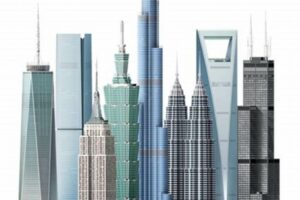Skyscrapers, towering structures that define modern skylines, rely heavily on glass for their facades, offering panoramic views and natural daylighting. The glass used in skyscrapers undergoes a specialized manufacturing process to ensure its strength, durability, and aesthetic appeal.
Float glass, the primary type used in skyscrapers, is produced by floating molten glass on a bed of molten tin. This process creates a smooth, distortion-free surface ideal for large-scale architectural applications. To enhance its strength, the glass is subjected to a tempering process, which involves rapid heating and cooling, increasing its resistance to breakage and thermal stress.
Beyond its structural properties, the glass used in skyscrapers also plays a crucial role in energy efficiency and sustainability. Advanced coatings and laminations can reduce heat transfer, minimizing energy consumption for heating and cooling. Moreover, the transparency of glass allows for ample natural daylighting, reducing the need for artificial lighting and contributing to occupant well-being.
The production of glass for skyscrapers is a complex and technologically advanced process, involving specialized equipment and expertise. Leading manufacturers invest heavily in research and development to continually improve the performance and aesthetics of architectural glass.
In conclusion, the glass used in skyscrapers is a critical component that contributes to their structural integrity, energy efficiency, and aesthetic appeal. The manufacturing process involves specialized techniques and cutting-edge technology to meet the demanding requirements of high-rise buildings.
1. Float glass
Float glass is the primary type of glass used in skyscrapers because it is a strong, durable, and cost-effective material that can be produced in large sizes. The float glass manufacturing process involves floating molten glass on a bed of molten tin, which results in a smooth, distortion-free surface. This process makes float glass ideal for use in large-scale architectural applications, such as skyscrapers.
Float glass is an important component of skyscrapers because it provides the building with its exterior skin. The glass facade of a skyscraper must be able to withstand wind, rain, and other elements, and it must also be able to provide thermal insulation. Float glass meets all of these requirements, making it the ideal choice for use in skyscrapers.
One of the most iconic examples of a skyscraper that uses float glass is the Burj Khalifa in Dubai. The Burj Khalifa is the tallest building in the world, and its facade is made entirely of float glass. The glass facade of the Burj Khalifa is able to withstand the extreme heat and wind conditions of the desert, and it also provides the building with excellent thermal insulation.
Float glass is a versatile material that can be used in a variety of architectural applications. However, it is particularly well-suited for use in skyscrapers because of its strength, durability, and cost-effectiveness. Float glass is an essential component of skyscrapers, and it plays a vital role in the safety and comfort of the people who live and work in these buildings.
2. Tempering
Tempering is a crucial step in the manufacturing process of glass for skyscrapers. By rapidly heating and cooling the glass, tempering increases its strength and durability, making it more resistant to breakage and thermal stress. This process is essential for ensuring the safety and integrity of skyscrapers, which are subjected to extreme wind loads and temperature fluctuations.
Tempered glass is four to five times stronger than annealed glass, which is the standard type of glass used in windows and other non-structural applications. This increased strength is achieved by creating a compressive stress on the surface of the glass, while the interior remains in tension. This stress distribution makes the glass more resistant to bending and impact forces.
In addition to its increased strength, tempered glass is also more resistant to thermal stress. This means that it is less likely to crack or shatter when exposed to sudden temperature changes. This is important for skyscrapers, which are often exposed to extreme temperature variations, both inside and outside.
Tempered glass is used in a variety of applications in skyscrapers, including windows, curtain walls, and skylights. It is also used in structural applications, such as beams and columns. The use of tempered glass in skyscrapers helps to ensure the safety and integrity of these buildings, making them more resistant to wind, earthquakes, and other natural disasters.
3. Coatings
In the context of “where do the glass for skyscrapers come from”, advanced coatings play a crucial role in enhancing the energy efficiency of these towering structures. These specialized coatings are applied to the glass during the manufacturing process to reduce heat transfer, which minimizes energy consumption for heating and cooling.
- Reflective coatings: These coatings reflect a significant portion of solar radiation away from the building, reducing the amount of heat that enters the interior space. This can lead to substantial energy savings, especially in warm climates.
- Low-emissivity (low-e) coatings: Low-e coatings reduce the emissivity of the glass, which is its ability to radiate heat. This helps to keep the interior of the building warmer in winter and cooler in summer, reducing the need for heating and cooling.
- Spectrally selective coatings: These coatings are designed to transmit visible light while reflecting infrared radiation. This allows natural daylight to enter the building while minimizing heat gain. Spectrally selective coatings can be particularly effective in reducing and improving occupant comfort.
- Self-cleaning coatings: These coatings are applied to the exterior of the glass to prevent dirt and debris from adhering to the surface. This helps to maintain the transparency of the glass and reduces the need for cleaning, which can be a challenging and costly task in high-rise buildings.
By incorporating advanced coatings into the glass used in skyscrapers, architects and engineers can significantly reduce the energy consumption of these buildings. This contributes to their overall sustainability and environmental performance, making them more cost-effective to operate and more environmentally friendly.
4. Laminations
In the context of “where do the glass for skyscrapers come from,” laminations play a critical role in enhancing the safety and structural integrity of these towering structures. Laminated glass is created by bonding multiple layers of glass together with a plastic interlayer, typically made of polyvinyl butyral (PVB) or ethylene-vinyl acetate (EVA).
- Title of Facet 1: Enhanced Strength
By combining multiple layers of glass, laminated glass offers significantly increased strength compared to single-layer glass. The plastic interlayer acts as a tough, flexible membrane that holds the glass layers together, preventing them from shattering into sharp fragments upon impact. This enhanced strength is crucial for skyscrapers, which are subjected to high wind loads and potential seismic activity.
- Title of Facet 2: Improved Safety
Laminated glass provides exceptional safety benefits in the event of breakage. When impacted, the plastic interlayer holds the broken glass fragments together, reducing the risk of injury from falling glass shards. This is particularly important in high-rise buildings, where falling glass could pose a significant hazard to people below.
- Title of Facet 3: Sound Insulation
The plastic interlayer in laminated glass also acts as a sound barrier, effectively reducing noise transmission. This is beneficial in skyscrapers, where noise pollution from traffic and other sources can be a concern. Laminated glass can help create a quieter and more comfortable indoor environment for occupants.
- Title of Facet 4: UV Protection
Laminated glass can be treated with UV-protective coatings to block harmful ultraviolet radiation from entering the building. This helps protect interior furnishings, artwork, and occupants from the damaging effects of UV exposure.
The use of laminated glass in skyscrapers is a testament to its exceptional strength, safety, and performance benefits. These laminations contribute to the overall structural integrity and safety of these towering structures, ensuring the well-being of their occupants and enhancing the overall quality of the built environment.
5. Manufacturers
In exploring the connection between this statement and “where do the glass for skyscrapers come from,” it is evident that leading manufacturers play a pivotal role in the advancement and innovation of architectural glass used in skyscrapers.
The continuous investment in research and development by these manufacturers directly contributes to the evolution of glass performance and aesthetics. They dedicate significant resources to exploring new technologies, materials, and processes to enhance the quality and functionality of architectural glass.
For instance, advancements in glass coating technology have led to the development of high-performance coatings that improve energy efficiency, reduce solar heat gain, and enhance occupant comfort. Manufacturers invest in developing these coatings to meet the growing demand for sustainable and energy-efficient buildings.
Moreover, manufacturers focus on improving the structural integrity and safety of architectural glass. Through research and development, they create stronger and more durable glass products that can withstand extreme weather conditions and seismic forces. This is crucial for skyscrapers that must maintain their structural stability in challenging environments.
The practical significance of understanding this connection lies in recognizing the importance of ongoing innovation in the architectural glass industry. Leading manufacturers drive this innovation through their research and development efforts, ultimately shaping the future of glass for skyscrapers and contributing to the creation of safer, more sustainable, and aesthetically pleasing high-rise structures.
6. Sustainability
In the context of “where do the glass for skyscrapers come from,” the sustainability aspect of architectural glass is closely intertwined with the use of natural daylighting. The transparency of glass allows ample natural light to penetrate the building’s interior, reducing the reliance on artificial lighting.
- Title of Facet 1: Energy Efficiency
The use of natural daylighting can significantly reduce energy consumption in skyscrapers. By minimizing the need for artificial lighting during daytime hours, buildings can conserve a substantial amount of energy. This energy efficiency not only translates into cost savings but also contributes to the overall sustainability of the building.
- Title of Facet 2: Occupant Well-being
Natural daylighting has a positive impact on the well-being of building occupants. Studies have shown that exposure to natural light can improve mood, cognitive function, and overall health. In skyscrapers, the use of glass facades allows occupants to connect with the outdoors and experience the benefits of natural light, even when working or living in high-rise environments.
- Title of Facet 3: Reduced Environmental Impact
The reduced reliance on artificial lighting due to the transparency of glass contributes to a lower environmental impact. Artificial lighting systems consume a significant amount of energy and often rely on fossil fuels. By maximizing natural daylighting, skyscrapers can decrease their carbon footprint and promote environmental sustainability.
In conclusion, the sustainability of architectural glass in skyscrapers is directly tied to its ability to provide ample natural daylighting. This not only enhances energy efficiency and occupant well-being but also contributes to the overall environmental sustainability of these towering structures.
7. Technology
The production of architectural glass for skyscrapers is a highly specialized and technologically advanced field. It requires sophisticated equipment, skilled professionals, and innovative techniques to achieve the desired performance, durability, and aesthetic qualities.
- Title of Facet 1: Advanced Manufacturing Techniques
The manufacturing of architectural glass for skyscrapers involves advanced techniques such as float glass production, tempering, coating, and lamination. These processes require specialized equipment and expertise to precisely control the temperature, pressure, and chemical composition to achieve the desired properties.
- Title of Facet 2: Quality Control and Testing
Stringent quality control measures are essential to ensure the safety and performance of architectural glass used in skyscrapers. Advanced testing facilities and equipment are employed to evaluate the strength, durability, optical clarity, and other characteristics of the glass to meet industry standards and building codes.
- Title of Facet 3: Research and Development
Ongoing research and development play a crucial role in advancing the technology used in architectural glass productio
n. Manufacturers and research institutions invest in exploring new materials, coatings, and processes to improve the energy efficiency, structural integrity, and aesthetic appeal of glass for skyscrapers. - Title of Facet 4: Skilled Professionals
The production of architectural glass for skyscrapers requires skilled professionals with expertise in various fields, including glass science, engineering, and manufacturing. Their knowledge and experience are essential to operate the specialized equipment, monitor the production process, and ensure the quality of the final product.
In conclusion, the production of glass for skyscrapers is a technologically advanced and specialized process that involves sophisticated equipment and skilled professionals. The advanced manufacturing techniques, stringent quality control measures, ongoing research and development, and the expertise of skilled professionals all contribute to the high performance, durability, and aesthetic appeal of architectural glass used in these towering structures.
FAQs on “Where Do the Glass for Skyscrapers Come From?”
This section answers frequently asked questions to provide a comprehensive understanding of the origin and production of glass used in skyscrapers.
Question 1: What type of glass is used in skyscrapers?
Answer: Float glass is the primary type used, produced by floating molten glass on a bed of molten tin. It undergoes tempering for enhanced strength and durability, making it suitable for skyscraper facades.
Question 2: How is the glass made strong enough to withstand high winds and seismic forces?
Answer: Tempering is a key process that increases the glass’s strength four to five times compared to standard glass. It creates a compressive stress on the surface, making it more resistant to bending and impact forces.
Question 3: How does the glass contribute to energy efficiency in skyscrapers?
Answer: Advanced coatings are applied to the glass to reduce heat transfer. Reflective coatings deflect solar radiation, low-emissivity coatings reduce heat loss, and spectrally selective coatings allow natural light while minimizing heat gain.
Question 4: What safety measures are incorporated into the glass used in skyscrapers?
Answer: Laminated glass is used, consisting of multiple glass layers bonded with a plastic interlayer. In case of breakage, the interlayer holds the fragments together, preventing sharp shards from scattering and enhancing safety.
Question 5: How do manufacturers ensure the quality and performance of the glass?
Answer: Leading manufacturers invest heavily in research and development to improve glass properties. They utilize advanced manufacturing techniques, implement stringent quality control measures, and collaborate with experts to meet industry standards and building codes.
Question 6: What are the environmental benefits of using glass in skyscrapers?
Answer: The transparency of glass allows for ample natural daylighting, reducing the need for artificial lighting and conserving energy. This contributes to lower carbon emissions and promotes sustainability in high-rise buildings.
Summary: Skyscraper glass is carefully engineered and manufactured using specialized techniques and advanced technologies. It meets stringent safety and performance requirements while contributing to energy efficiency and occupant well-being. Ongoing research and development ensure continuous improvements in the quality and sustainability of architectural glass used in these towering structures.
Transition: This comprehensive exploration of “Where Do the Glass for Skyscrapers Come From?” provides valuable insights into the production, properties, and significance of glass in modern architecture.
Tips to Understand “Where Do the Glass for Skyscrapers Come From”
To delve deeper into the topic of architectural glass used in skyscrapers, consider these insightful tips:
Tip 1: Explore Manufacturing Processes Get familiar with the float glass production method and the subsequent processes of tempering, coating, and laminating. Understanding these techniques provides a technical foundation for appreciating the glass’s properties. Tip 2: Consider Structural Properties Recognize the significance of tempered glass in skyscrapers. Its enhanced strength and durability are crucial for withstanding high winds and seismic forces, ensuring the safety and integrity of these towering structures. Tip 3: Focus on Energy Efficiency Learn about the advanced coatings applied to skyscraper glass. These coatings play a vital role in reducing heat transfer, contributing to energy efficiency and occupant comfort while minimizing environmental impact. Tip 4: Prioritize Safety Features Understand the importance of laminated glass in skyscrapers. Its multiple layers and plastic interlayer enhance safety by preventing sharp shards from scattering in the event of breakage. Tip 5: Appreciate Technological Advancements Recognize the ongoing research and development in architectural glass technology. Manufacturers continuously improve glass properties, leading to advancements in energy efficiency, structural integrity, and aesthetic appeal. Tip 6: Embrace Sustainability Consider the environmental benefits of glass in skyscrapers. Its transparency allows for ample natural daylighting, reducing reliance on artificial lighting and promoting energy conservation.
By incorporating these tips into your understanding of “where do the glass for skyscrapers come from,” you will gain a comprehensive perspective on the production, properties, and significance of architectural glass in modern high-rise buildings.
To further enhance your knowledge, continue reading the comprehensive article below for a detailed exploration of this fascinating topic.
Conclusion
The exploration of “where do the glass for skyscrapers come from” unveils the intricate processes and technologies behind the production and properties of architectural glass used in these towering structures. Skyscraper glass is not merely a transparent facade but a carefully engineered component that contributes to the safety, energy efficiency, and overall performance of the building.
The manufacturing processes, from float glass production to tempering, coating, and laminating, are crucial in achieving the desired strength, durability, and aesthetic qualities of skyscraper glass. Advanced coatings enhance energy efficiency by reducing heat transfer, while laminated glass prioritizes safety by preventing the scattering of sharp shards in the event of breakage.
The quest for continuous improvement in architectural glass technology underscores the significance of ongoing research and development. Manufacturers invest in exploring new materials, coatings, and processes to enhance energy efficiency, structural integrity, and aesthetic appeal. Furthermore, the environmental benefits of glass in skyscrapers cannot be overlooked, as its transparency promotes natural daylighting and reduces reliance on artificial lighting.
Understanding “where do the glass for skyscrapers come from” extends beyond technical knowledge; it highlights the importance of innovation, sustainability, and the pursuit of excellence in modern architecture. As skyscrapers continue to shape our skylines, the architectural glass used in their construction will undoubtedly play a vital role in defining the future of sustainable and awe-inspiring urban e
nvironments.







